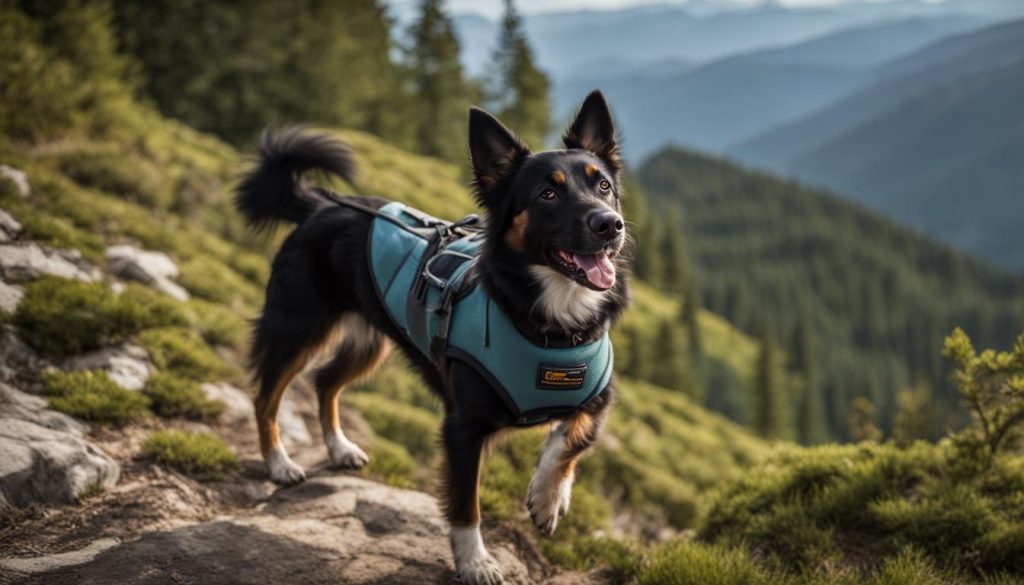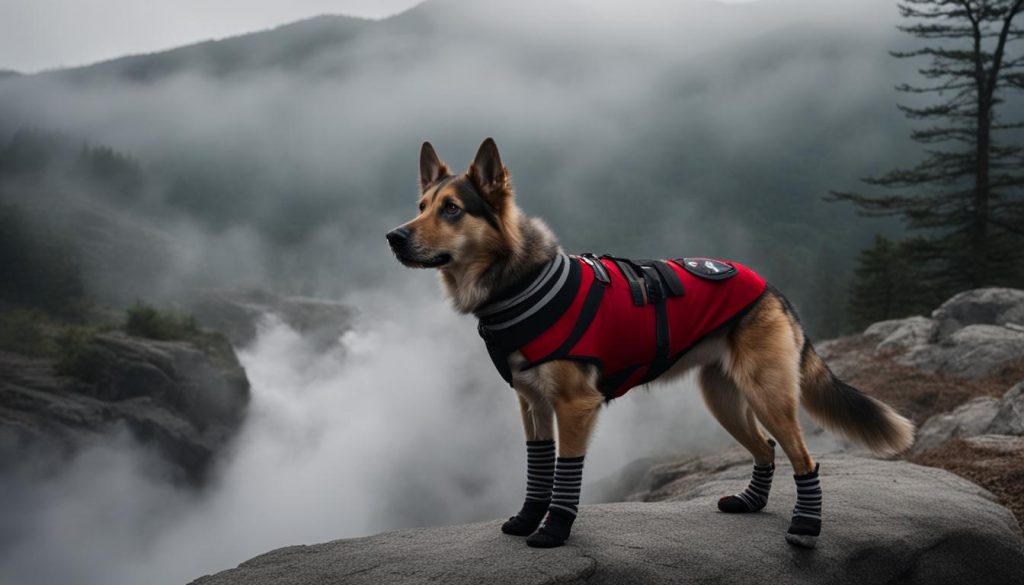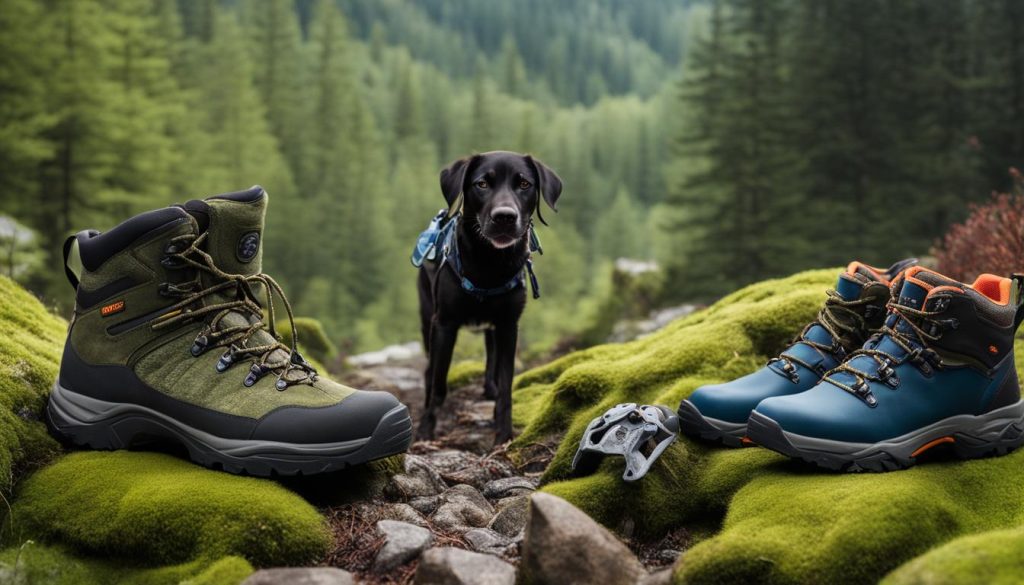When it comes to taking our furry companions on outdoor adventures, we often wonder whether dogs need shoes for hiking. While dogs are naturally equipped to handle various terrains, there are situations where footwear can provide added protection and comfort. In this article, I will delve into the topic of dog shoes for hiking, discussing their benefits, drawbacks, and whether they are necessary for your canine companion.
Key Takeaways:
- Dogs generally do not need to wear shoes for hiking, but they can provide protection against winter, hot pavement, and rocky terrain.
- Hiking shoes or boots can benefit older dogs by improving stability, traction, and safety.
- Introduce your dog gradually to wearing boots and ensure a proper fit for comfort and functionality.
- Some dog breeds may benefit more from wearing boots due to their origin or specific climatic conditions.
- If your dog refuses to wear boots, alternatives such as paw wax or dog socks can be considered.
Should Dogs Wear Shoes When Hiking?
Dog boots can play a crucial role in protecting your furry friend’s paws while hiking. These shoes provide an extra layer of defense against potential injuries from sharp rocks, pointy sticks, and other hazards on the trail. Additionally, boots help shield your dog’s paws from extreme temperatures, such as the scorching heat of the pavement or the freezing cold of winter hikes.
It’s not just about physical protection; dog boots also offer increased stability and traction. This is particularly beneficial for older dogs who may have reduced mobility or stability. By improving their grip on rough terrain, hiking boots can help prevent slips and falls, ensuring a safer and more enjoyable hiking experience for your four-legged companion.
“Dog boots can play a crucial role in protecting your furry friend’s paws while hiking.”
While most dogs do not require boots for everyday walks or short hikes, they can greatly benefit from them in certain situations. For example, if you plan to hike on rocky terrain or in extreme weather conditions, investing in a pair of high-quality dog boots can provide peace of mind and ensure your dog’s comfort and safety.
Table: Pros and Cons of Dog Boots
| Pros | Cons |
|---|---|
| Protection from sharp objects and extreme temperatures | Some dogs may resist wearing boots |
| Improved stability and traction | Initial adjustment period for dogs |
| Reduced risk of paw pad injuries | Challenging to find the right fit |
| Comfort and padding for long hikes | Prevents natural hardening of paw pads |
Keep in mind that not all dogs may tolerate wearing boots initially. You should also introduce them gradually and provide positive reinforcement through treats and praise. Additionally, finding the right fit is crucial for your dog’s comfort and safety. Take accurate measurements of your dog’s paw length and width, following the manufacturer’s guidelines, and try on different options until you find the perfect fit.
To sum it up, while dogs may not need shoes for every hiking adventure, boots can provide invaluable protection and support in certain situations. By investing in high-quality dog boots and ensuring a proper fit, you can safeguard your dog’s paws and enhance their hiking experience, no matter the terrain or weather conditions.

How Does Your Dog Benefit From Hiking Shoes?
Dog hiking shoes offer several benefits for your furry companion’s paws. These shoes provide increased stability and traction, which is especially important for older dogs who may have reduced mobility. The rubber soles on dog boots are designed to grip the ground better, improving traction on uneven terrain, snowy patches, or icy surfaces. This helps your dog maintain their balance and reduces the risk of slipping or getting injured.
Hiking shoes for dogs also offer extra padding and protection for your dog’s feet. The shoes act as a barrier against unforeseen obstacles, sharp objects, extreme temperatures, and rough terrain. They prevent blistering and help reduce the chances of cracked paws. In addition, hiking shoes can provide comfort and relief for dogs with sensitive paws, allergies, or other paw conditions.
Why Should You Consider Dog Hiking Shoes?
There are several reasons why you should consider investing in dog hiking shoes. Firstly, they protect your dog’s paws from hot pavement during summer hikes. The pavement can reach scorching temperatures that can burn your dog’s feet, causing pain and discomfort.
Secondly, hiking shoes for dogs are essential during winter hikes. Cold surfaces, ice, and snow can cause frostbite and discomfort to your dog’s paws. The shoes act as insulation and prevent the cold from directly impacting their feet.
“Dog hiking shoes provide extra stability, traction, and protection for your canine companion, ensuring they can enjoy their outdoor adventures to the fullest.”
Lastly, hiking shoes protect your dog’s feet from sharp rocks, sticks, thorns, and other hazardous objects they may encounter on the trail. This greatly reduces the risk of cuts, injuries, and infections, allowing your dog to explore safely and comfortably.

Are There Any Drawbacks to Dog Boots?
While dog boots offer several benefits, you should consider their potential drawbacks before deciding to invest in a pair for your canine companion. Here are some key considerations:
1. Discomfort and Resistance
Some dogs may initially find wearing boots uncomfortable and may resist having them on their paws. This resistance can manifest in various ways, from pawing at the boots to actively trying to remove them. It may take time and patience to acclimate your dog to wearing boots, and some dogs may never fully adjust.
2. Altered Gait and Balance
When dogs first start wearing boots, their gait and balance may be affected. They may walk differently or appear less steady on their feet. This is normal and should improve as your dog becomes more accustomed to wearing the boots. However, monitor your dog’s comfort and safety during this adjustment period.
3. Finding the Right Fit
Choosing the right size of boots for your dog can be challenging. Dogs’ paw sizes can vary significantly, and finding a boot that fits properly is crucial for both comfort and functionality. Ill-fitting boots may cause discomfort, restrict movement, or even pose a safety risk. Taking accurate measurements of your dog’s paws and carefully following the manufacturer’s sizing guidelines can help in finding the right fit.
4. Possible Impact on Paw Health
Regularly wearing boots may prevent a dog’s paws from naturally hardening and building resistance to their environment. This can make their paws more susceptible to injury or sensitivity when they are not wearing boots. I recommend that you strike a balance between providing protection and allowing your dog’s paws to adapt and develop their own resilience.
While dog boots have their drawbacks, they can still be a valuable tool for protecting your dog’s paws in certain situations. By considering your dog’s comfort, the specific demands of your hiking terrain, and alternative options such as paw wax or dog socks, you can make an informed decision on whether or not to invest in dog boots.
| Drawbacks of Dog Boots | |
|---|---|
| Discomfort and Resistance | Some dogs may initially find wearing boots uncomfortable and may resist having them on their paws. |
| Altered Gait and Balance | When dogs first start wearing boots, their gait and balance may be affected. |
| Finding the Right Fit | Choosing the right size of boots for your dog can be challenging. |
| Possible Impact on Paw Health | Regularly wearing boots may prevent a dog’s paws from naturally hardening and building resistance to their environment. |
Are There Any Dog Breeds That Need Booties More Than Others?
In determining whether or not a dog breed may require booties, you should consider factors such as the breed’s origin, climate, and individual sensitivity to environmental conditions. Certain breeds may benefit more from wearing booties, especially during hiking or outdoor activities. Here are some examples of breeds that may require booties for paw protection:
- Chihuahuas: These small dogs are more susceptible to cold weather due to their size. Booties can help keep their paws warm during winter hikes or in snow-covered areas.
- Bernese Mountain Dogs or Siberian Huskies: Breeds originating from cold climates may have thicker fur but may still require booties for protection against icy surfaces or extreme temperatures.
- Breeds Prone to Allergies or Sensitive Paws: Some breeds are more susceptible to allergies or have sensitive paws, making them more prone to discomfort or irritation from rough terrain or hot pavement. Booties can help provide an extra layer of protection.
I recommend that you remember that while these breeds may benefit more from wearing booties, individual reactions and needs may vary. Observing your dog’s comfort and monitoring their paw condition during outdoor activities can help determine whether booties are necessary for their well-being.

| Breed | Climate | Paw Sensitivity | Booties Recommendation |
|---|---|---|---|
| Chihuahua | Cold | Low | High |
| Bernese Mountain Dog | Cold | Medium | Medium |
| Siberian Husky | Cold | Low | Medium |
| Labrador Retriever | Variable | Low | Low |
| Poodle | Variable | Medium | Medium |
Table: Dog Breeds and Booties Recommendation
Tips for Keeping Dog Booties On
When it comes to keeping dog booties on, there are a few tips and tricks that can help ensure they stay put during your outdoor adventures. Here are some strategies to consider:
1. Introduce the boots gradually:
Before heading out for a hike, get your dog used to wearing the boots. Start by trying them on at home for short periods of time. Gradually increase the duration until your dog feels comfortable wearing them for longer walks. Positive reinforcement with treats and praise can help make the experience more enjoyable for your furry friend.
2. Ensure a proper fit:
The key to keeping dog booties on is finding the right size. You should also measure your dog’s paw length and width accurately according to the manufacturer’s instructions. Boots that are too tight can cause discomfort, while those that are too loose may fall off easily. Take the time to find the perfect fit for your dog’s paws to ensure maximum comfort and functionality.
3. Consider alternative solutions:
If your dog continues to have difficulty keeping the boots on, there are alternative options to consider. Paw wax can provide a protective layer to your dog’s paws against extreme temperatures and soothe cracked or scraped paw pads. Dog socks can also be more comfortable for some dogs and offer protection from extreme temperatures. However, these alternatives may not offer the same level of protection as boots against sharp objects or rough terrain.
By following these tips and considering your dog’s comfort and preferences, you can help ensure that their booties stay on during your hikes and outdoor adventures, providing them with the extra protection they need.

Best Dog Boot Alternatives
While dog boots provide excellent protection for your furry friend’s paws during hikes or outdoor adventures, some dogs may find them uncomfortable or refuse to wear them. Fortunately, there are alternatives to dog boots that can still offer paw protection and comfort. Two popular options are paw wax and dog socks.

Paw Wax
Paw wax is a great alternative to dog boots, especially for dogs who don’t enjoy wearing shoes. Paw wax creates a protective barrier on your dog’s paws, shielding them from extreme temperatures, rough surfaces, and harmful chemicals. The wax also helps soothe cracked or scraped paw pads, promoting healing and preventing further damage. Simply apply the paw wax to your dog’s pads before heading out on a hike, ensuring complete coverage. Paw wax is easy to apply and non-toxic, making it safe for your dog to lick off.
Dog Socks
Dog socks can be a comfortable and practical alternative to dog boots. Made from soft, breathable materials, dog socks provide a layer of protection against hot pavement, rough terrain, and cold surfaces. They also offer added traction to prevent slipping and sliding. Dog socks come in various sizes and designs, allowing you to choose the perfect fit for your pup. while dog socks provide paw protection, they may not offer the same level of durability and resistance as boots, especially in extreme weather or rough conditions.
When deciding between paw wax and dog socks as alternatives to dog boots, consider your dog’s comfort, specific needs, and the environment in which you’ll be hiking. Some dogs may prefer the feel of socks, while others may tolerate paw wax better. Ultimately, the goal is to provide your furry friend with the necessary protection and comfort to enjoy outdoor adventures to the fullest.
Should You Buy Hiking Shoes For Your Dog?
When it comes to deciding whether or not to buy hiking shoes for your dog, there are several factors to consider. The specific needs of your dog, the environment in which you will be hiking, and your own personal preferences all play a role in this decision. Hiking shoes can provide an added layer of protection for your dog’s paws, but they are not necessary for every dog or every hiking situation.
One option for protecting your dog’s paws is to use alternative solutions such as paw wax or dog socks. Paw wax provides a protective layer against extreme temperatures and can help soothe cracked or scraped paw pads. Dog socks can be more comfortable for some dogs and provide protection from extreme temperatures. However, you should note that these alternatives may not offer the same level of protection as hiking shoes against sharp objects or rough terrain.
If you do decide to invest in hiking shoes for your dog, it is good practice to find the right pair. Proper fit is essential for comfort and functionality. Take accurate measurements of your dog’s paw length and width according to the manufacturer’s instructions. It may require trying different types and brands to find the best fit for your dog. Local stores where you can try the boots on your dog are also recommended to ensure a proper fit.
Table: Pros and Cons of Dog Hiking Shoes
| Pros | Cons |
|---|---|
| Extra protection for paws | Some dogs may not tolerate wearing shoes |
| Improved stability and traction | Dogs may need time to adjust to wearing shoes |
| Reduced soreness and discomfort | Finding the right size can be challenging |
| Protection against unforeseen obstacles | Wearing shoes too often may prevent natural hardening of paws |
Ultimately, the choice to buy hiking shoes for your dog’s paws depends on the specific needs of your dog and your own preferences. If you believe your dog would benefit from the added layer of protection and stability that shoes provide, there are numerous brands and options available. You should read customer reviews and consider factors such as snow and ice, extreme temperatures, or hazards when choosing the right shoes for your dog.

How to Find a Good Pair of Dog Boots
When it comes to choosing the right dog boots for your furry companion, consider a few key factors. Finding the perfect fit, ensuring durability, and prioritizing comfort are essential for the overall well-being of your dog. Here are some tips to help you find the best pair of dog boots:
1. Measure your dog’s paws accurately
Before purchasing dog boots, please measure your dog’s paws accurately. This will ensure a proper fit and prevent any discomfort or restrictions. Follow the manufacturer’s instructions to measure both the length and width of your dog’s paws. Take multiple measurements to ensure accuracy, as some dog breeds may have different paw sizes.
2. Consider the style and design
There are various styles and designs of dog boots available, each catering to different needs and preferences. Some boots are designed for specific activities like hiking or snow walking, while others offer all-around protection. Consider the type of terrain your dog will encounter and choose boots that provide the necessary level of grip and protection.
3. Read customer reviews
Customer reviews can be valuable sources of information when selecting dog boots. Look for reviews from pet owners with dogs of a similar breed or size as yours. Pay attention to feedback regarding durability, ease of use, and overall satisfaction. This will give you a better understanding of the product’s quality and reliability.
4. Try the boots on your dog before purchasing
If possible, visit a local pet store where you can try the boots on your dog before making a purchase. This will allow you to assess the fit and comfort level firsthand. Observe your dog’s reaction and gait while wearing the boots to ensure they are comfortable and not causing any discomfort or restriction of movement.
| Benefits of Finding the Right Dog Boots | Tips for Finding the Right Dog Boots |
|---|---|
| 1. Protection against sharp objects and extreme temperatures | 1. Measure your dog’s paws accurately |
| 2. Enhanced stability, traction, and comfort | 2. Consider the style and design |
| 3. Prevention of paw pad injuries and soreness | 3. Read customer reviews |
| 4. Long-lasting durability for extended use | 4. Try the boots on your dog before purchasing |
Finding the right pair of dog boots may require some trial and error, but it’s worth the effort to ensure the safety and comfort of your beloved pet. By considering the tips mentioned above, you can make an informed decision and find the perfect boots to accompany your dog on all their outdoor adventures.

Do Dogs Need Boots for Snow Hiking?
When it comes to hiking in snowy conditions with your furry companion, the question of whether dogs need boots arises. While dogs have natural protection on their paws, the cold, wet, and icy conditions can still pose risks. Dog boots can provide several benefits and reasons for wearing them in the snow.
Firstly, boots offer protection against the harsh elements. They create a barrier between your dog’s paws and the cold, wet snow, preventing frostbite and keeping their paws dry. Boots also protect against ice, preventing slips and falls that could result in injuries.
Furthermore, wearing boots in the snow can help prevent contact with de-icing chemicals. These chemicals can be harmful to your dog’s paw pads and cause irritation or chemical burns. Boots provide a protective layer that keeps your dog’s paws safe from these substances.
Ultimately, the decision to use boots for snow hiking depends on the specific needs of your dog and the conditions you will encounter. Consider factors such as the temperature, snow consistency, and duration of the hike. It’s also crucial to choose boots that fit properly and are comfortable for your dog to wear. Taking these factors into account will ensure that your dog stays safe and comfortable during your snowy adventures together.

Benefits of Wearing Boots for Snow Hiking:
- Protection against frostbite and wet conditions.
- Prevention of slips and falls on icy surfaces.
- Shielding from harmful de-icing chemicals.
Things to Consider Before Using Boots for Snow Hiking:
- The temperature and duration of the hike.
- The fit and comfort of the boots.
- The snow consistency and potential hazards.
Overall, if you plan to take your dog on snow hikes, investing in a pair of boots can provide them with the necessary protection and ensure an enjoyable and safe experience for both of you.
Final Thoughts
To sum it up, while dogs generally do not need to wear boots for outdoor walks or hikes, they can provide an extra layer of protection and comfort in certain situations. Dog boots are particularly beneficial for protecting against hazards such as sharp rocks, pointy sticks, hot pavement, and extreme weather conditions. They also offer increased stability, traction, and padding for older dogs who may be less stable on uneven terrain.
However, you should consider your dog’s comfort and preferences when deciding on the need for boots. Some dogs may initially struggle to adjust to wearing boots, so I would advise that you introduce them gradually and provide positive reinforcement. Additionally, finding the right fit is good practice to ensure the boots are both safe and comfortable for your dog.
If your dog refuses to wear boots or finds them uncomfortable, alternative options such as paw wax and dog socks can provide some level of protection. These alternatives may not offer the same level of protection against sharp objects or rough terrain, but they can still help protect against extreme temperatures and provide some comfort.
In the end, the decision to invest in dog boots depends on the specific needs of your dog and your own preferences. Consider factors such as your dog’s breed, the climate you live in, and the type of hiking or outdoor activities you engage in. By prioritizing your dog’s safety and well-being, you can make an informed choice about whether or not they need boots for their paws.
FAQ
Do dogs need shoes for hiking?
Dogs generally do not need to wear booties or shoes outdoors, but they can provide extra protection on rough terrain or in extreme weather conditions.
Should dogs wear shoes when hiking?
While not necessary for most dogs, shoes can protect their paws from injuries, provide stability, and offer traction on slippery surfaces.
How does your dog benefit from hiking shoes?
Hiking shoes or boots can improve stability, traction, and safety for older dogs, and provide comfort and protection against sharp objects and extreme temperatures.
Are there any drawbacks to dog boots?
Some dogs may not like wearing boots, and finding the right size can be challenging. Wearing boots too often may prevent natural paw hardening and building resistance.
Are there any dog breeds that need booties more than others?
Certain dog breeds, like Chihuahuas in cold weather or Bernese Mountain Dogs in hot weather, may benefit more from wearing booties due to their specific needs.
How to keep booties on my dog?
Introduce boots gradually, provide positive reinforcement, ensure proper fit, and consider alternatives like paw wax or dog socks if your dog refuses to wear boots.
What are the best dog boot alternatives?
Paw wax provides protection and soothes paw pads, while dog socks can be more comfortable. However, they may not offer the same level of protection as boots on rough terrain.
Should you buy hiking shoes for your dog?
The decision to buy hiking shoes for your dog depends on their specific needs and your personal preference. Consider factors like weather conditions and hazards when choosing the right shoes.
How to find a good pair of dog boots?
Measure your dog’s paw accurately, try different brands and types, and ensure proper fit for comfort and functionality. Trying boots on at a local store is recommended.
Do dogs need boots for snow hiking?
Dog boots can provide traction, protect paws from cold and sharp ice, and prevent exposure to harmful chemicals used for snow and ice melting during snow hiking.
Final Thoughts
While dogs generally do not need boots for outdoor walks or hikes, they can provide an extra layer of protection and comfort in certain situations. The decision to invest in dog boots depends on the specific needs of your dog and your own preferences.






